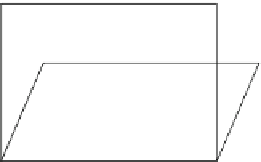Biology Reference
In-Depth Information
Fig. 5.8 A three-dimensional
hypercube. One of the eight
vertices is arbitrarily located
at the origin (0, 0, 0) of the
(
x
,
y
, i) coordinate system.
Point A denotes the center
of the hypercube. The closest
vertex to point F is C(0, 1, 1),
whose complement is vertex
C
C
(1, 0, 0)
C (
0, 1, 1
)
(
1, 1, 1
)
* F
(
1/3, 3/4, 7/8
)
(
0, 0, 1
)
(
1, 0, 1
)
* A
(
1/2, 1/2, 1/2
)
(
0, 1, 0
)
(
1, 1, 0
)
(
0, 0, 0
)
C
C
(
1, 0, 0
)
three-dimensional hypercube (see Fig.
5.8
). A square (e.g., one of the six aspects
of a cube) can be treated as a two-dimensional hypercube. To generate a cube
from a square, it is necessary only to move a square in a new direction (i.e., along
the
z
-axis) perpendicular to the preexisting axes, the
x
- and
y
-axes in the case of a
square. This operation can be repeated to generate an N-dimensional hypercube
from an (N
1)-dimensional one, where N can be any arbitrarily large number.
5. According to the principle of excluded middle, also called
the Aristotelian logic
or
crisp logic
(McNeill and Freiberger 1993; Kosko 1993), an answer is either
true (1) or false (0), and no answer can have any truth values intermediate
between 0 and 1. That is, no “crisp” answer can reside in the interior or on the
edges of the hypercube, only on the vertices.
6. In contrast, the theory of fuzzy sets or the fuzzy logic (Zadeh 1965, 1995,
1996a, b; Kosko 1993) allows the truth value of an answer to be any positive
number between 0 and 1, inclusive. For example, an answer with a truth value
(i.e., the degree of membership to a set of true answers) of 3/4 is more true (1)
than false (0); an answer with a truth value of 1/2 is both true and not-true at the
same time, etc. The unit of fractional truth values is referred to as “fits” or
“fuzzy units” (Kosko 1993).
7. Based on (5) and (6), we can conclude that “crisp” answers (expressed in bits)
reside at the vertices or nodes of an N-dimensional hypercube, while fuzzy or
vague answers (expressed in fits) reside in the interior or on the edges of the
N-dimensional hypercube. For example, a fuzzy answer with a truth value of
(1/2, 1/2, 1/2) will be found at the center of the cube (see point A in Fig.
5.8
),
whereas a fuzzy answer with truth value of (1/3, 3/4, 7/8) will be located at
point F in Fig.
5.8
.
8. It is postulated here that when the human mind is challenged with a set of N
questions, it generates a fuzzy answer (say, F in Fig.
5.8
)
unconsciously
(guided
by intuition and previous experience), but, in order to communicate (or articu-
late) it to others, the human mind
consciously
search for the
nearest vertex
, say
(0, 1, 1) in Fig.
5.8
. Thus,
articulated
or
represented
crisp answers can be



